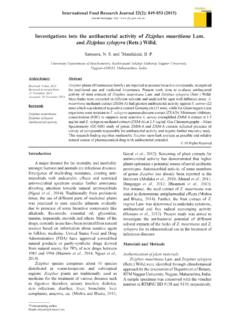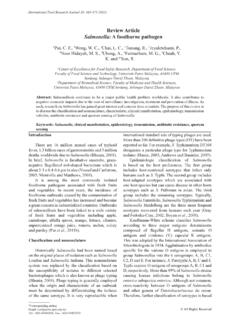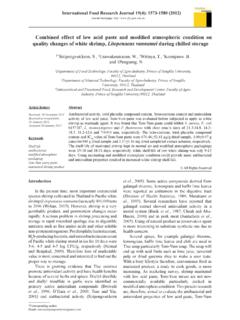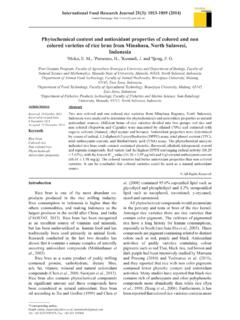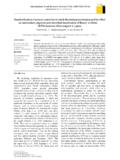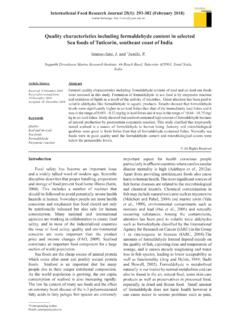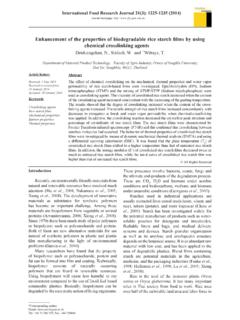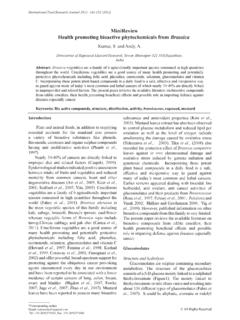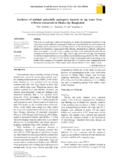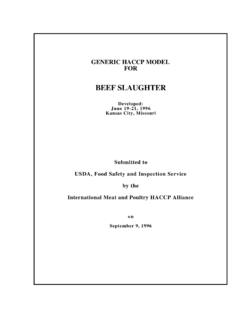Transcription of Application of ISO 22000 in comparison with …
1 All Rights Reserved*Corresponding author. Email: / +233 (0) 244 685893 International Food Research Journal 20(4): 1771-1781 (2013)Journal homepage: *Afoakwa, E. O, 2 Mensah-Brown, H., 1 Crentsil, G. K., 3 Frimpong, K. and 3 Asante, F. 1 Department of Nutrition & Food Science, University of Ghana, Legon-Accra, Ghana2 Department of Food Process Engineering, University of Ghana, Legon-Accra, Ghana3 Cocoa Processing Company of Ghana, P. O. Box 40, Tema, GhanaApplication of ISO 22000 in comparison with HACCP on industrial processing of milk chocolate AbstractHazard analysis was conducted to identify critical control points (CCPs) during cocoa processing and milk chocolate manufacture and applied into a hazard analysis and critical control point (HACCP) plan.
2 During the process, the different biological, physical and chemical hazards identified at each processing stage in the hazard analysis worksheet were incorporated into the HACCP plan to assess the risks associated with the processes. Physical hazards such as metals, stones, fibres, plastics and papers; chemical hazards such as pesticide residues, mycotoxins and heavy metals; and microbiological hazards such as Staphyloccous aureus, coliforms, Salmonella, Aspergillus and Penicillium were identified. ISO 22000 analysis was conducted for the determination of some pre-requisite programmes (PrPs) during the chocolate processing and compared with the HACCP system.
3 The ISO 22000 Analysis worksheet reduced the CCPs for both cocoa processing and chocolate manufacture due to the elimination of the pre-requisite programmes (PrPs). Monitoring systems were established for the CCPs identified and these included preventive measures, critical limits, corrective actions, assignment of responsibilities and verification procedures. The incorporation of PrPs in the ISO 22000 made the system simple, more manageable and effective since a smaller number of CCPs were safety is linked with food-borne hazards present in food at the point of consumption. Since food safety hazards can occur at any stage in the food chain it is essential that adequate control measures be put in place to avoid or minimize food safety hazards (Prati and McIntyre, 2004).
4 ISO 22000 is a standard developed by the International Organization for Standardization (ISO) as a requirement for the food chain organization to enhance food safety (Blank, 2006). It was developed as an improvement to ISO 9000. In comparison with ISO 9000, the standard is more procedure-orientated than principle-based. The ISO 22000 international standard specifies the requirements for a food safety management system. It involves the elements of interactive communication, system management, pre-requisite programmes and HACCP principles. According to ISO (2010), ISO 22000 can be applied independently of other management system standards or integrated with existing management system Hazard Analysis and Critical Control Points (HACCP) system is science based and systematic.
5 It identifies specific hazards and measures for their control to ensure the safety of food. Any HACCP system is capable of accommodating change, such as advances in equipment design, processing procedures or technological developments (Codex Alimentarius Commission, 1999). Its concept permits a systematic approach to the identification of hazards and an assessment of the likelihood of their occurrence during the manufacture, distribution and use of a food product, and defines measures for their control (van Schothorst, 2004). The resulting HACCP plan can be integrated in a more general quality and safety assurance the last 20 years, chocolate products have been the cause of many salmonellosis outbreaks involving mainly children (Cordier, 1994).
6 The main reason has been the very low levels of Salmonella found in such contaminated chocolate products. Additionally, chocolate may contain other spoilage organisms such as yeasts and molds, Staphylococcus aureus and other coliforms. Molds may spoil chocolate by hydrolyzing lipids present to fatty acids. This results in the rancid taste of chocolate. It is therefore necessary to take preventive measures during processing to avoid re-contamination of the product after the roasting step which represents the only barrier for Salmonella and other spoilage microorganisms (Case, 2010). HACCP systems are KeywordsFood safetyCocoaChocolateCritical control point HACCPISO 22000 Pre-requisite programmesArticle historyReceived: 23 January 2013 Received in revised form: 10 March 2013 Accepted: 13 March 20131772 Afoakwa et 20(4):1771-1781therefore designed to prevent re-contamination.
7 The control of hazards in chocolate processing is essential since the consequences of its failure can be illustrated by a number of serious and high profile incidents and recalls over the past decade. Such incidents can cause illness, injury or in the most severe cases, death to the consumer (Burndred, 2009). Hazard Analysis and Critical Control Points (HACCP)The basis of HACCP are that it is a process control rather than a product control procedure and that it focuses on controlling steps in the processing system that are critical to consumer health (Arvanitoyannis and Varzakas, 2008). HACCP is a structured approach to the identification, assessment of risk (likelihood of occurrence and severity), and control of hazards associated with food production process or practice.
8 It addresses the root causes of food safety problems in production, storage, transportation, and is preventative (FDA, 1994). It aims to identify possible problems before they occur and establish control measures at stages in the production process that are critical to product safety. One of the purposes of HACCP is to design safety into the process, thereby reducing the need for extensive microbiological testing of inline samples and finished products (Silliker, 1995). There can hardly be HACCP without Good Manufacturing or Management Practices (GMP). GMP is a description of all the steps in a processing facility, while HACCP is a documentation that the steps important to consumer health are under control (Arvanitoyannis and Varzakas, 2009).
9 Sanitation standard operating procedures (SSOPs) are also a needed pre-requisite to HACCP. Pre-requisites are advisory not mandatory. GMPs differ from HACCP in a number of ways. First, they are not designed to control specific hazards. Second, they do not provide methods for monitoring hazards and third, they do not require specific recordkeeping procedures (Arvanitoyannis and Varzakas, 2008).HACCP principles The HACCP principles are clearly defined and they are considered to be one of the most useful tools for proactive identification and control of hazards in foods. According to the Codex Alimentarius Commission (1999), the HACCP system consists of seven principles which have been well outlined by Arvanitoyannis and Varzakas (2009).
10 Advantages of HACCPHACCP offers a number of advantages overcurrent systems. Most importantly according to Llano (2011) it;i. Focuses on identifying and preventing hazards from contaminating Permits more efficient and effective government oversight, primarily because the record keeping allows investigators to see how well a firm is complying with food safety laws over a period rather than how well it is doing on a given Places responsibility for ensuring food safety appropriately on the food manufacturer or Helps food companies compete more effectively in the world Reduces barriers to international the advantages of HACCP according to Whitehead and Orris (1995) include;i.
